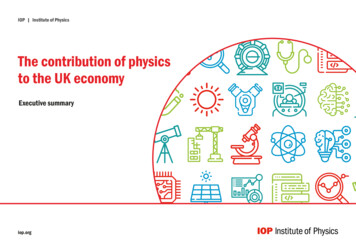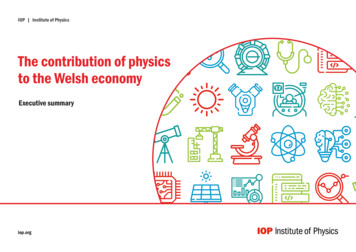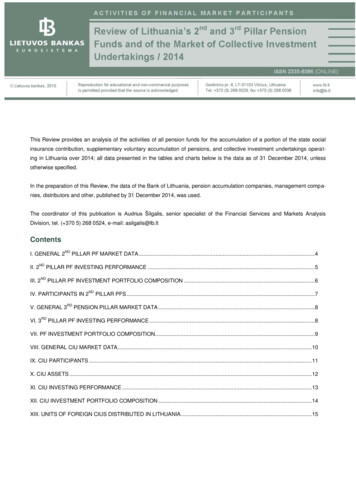
Transcription
IOP Institute of PhysicsThe contribution of physicsto the UK economyExecutive summaryiop.org
IOP Institute of PhysicsPhysics is a foundation stone for the UK economy andthe industries which use physics are both important andhighly productive. Physics-based industries (PBIs) employmore than 2.7 million full time equivalent (FTE) employeesnationwide, and contribute 11% of national gross domesticproduct (GDP). Labour productivity in the sector is strong at 84,300 per worker, per year.A project commissioned by the Institute of Physics (IOP) andconducted by the Centre for Economics and Business Research (CEBR)shows the performance and growth of the sector between 2010-2019.Read the full report at /physics-and-economy.What is the physics sector?Physics-based industries (PBIs) are industries whoseenterprises demonstrate A) ongoing research and development (R&D) which consistentlymakes use of physics knowledge (and the R&D activity can beexpected to significantly affect the fortunes of businesseswithin the industry), orB) t hose where underlying technology supporting theindustry requires significant physics knowledge forcontinued operation.The largest parts of the physics sector are Physics Manufacturing(which includes, but is not limited to, the production of a wide rangeof goods, from fibre optic cables to aircraft and medical equipmentto support civil and defence objectives) and Physics Science andTechnology, which includes, but is not limited to, technical testing andanalysis and practical scientific consultancy. Physics machine servicesand sales, along with medical equipment sales, represent downstreamservicing and sales of the goods physics manufacturing creates. Theenergy, oil and gas extraction and telecoms industries are majorstandalone industries with physics at their heart.iop.orgIn 2019 *All figures are rounded.Employment - Full time equivalents (FTEs - thousands)40.5%Total: 2,72037%3.7%7.7%Number of enterprises5.9%Total: 350.173.7%16.4%1.3%29.1%4.1% 2.04%2.4%0.06%Total: 229bnGross value added - GVA ( bn)31.4%9.6%14.2%6.8%3.2%Turnover - ( bn)24.1%4.7%0.5%5.7%Total: 634bn37.9%16.4%10.4%IndustryPhysics Science & TechnologyTelecomsPhysics ManufacturingPhysics MachineServicesEnergy Production, Transmission& DistributionGas & Oil ExtractionOther2.8% 4.6%3.8%
IOP Institute of PhysicsThe physics sector is highly productive and a significantcontributor to the UK economyIn 2019 GVA contributionThe physics sector directlygenerated 229bn Gross ValueAdded (GVA), 11% of total UKgross domestic product (GDP).This rose to 563bn whenindirect and induced economiccontributions are included.Across the decade.Turnover 563bn 229bnSectoral comparison 634bnThe turnover for the physics sectorin 2019.GVA contributionSectoral comparisonDirect GVA rose by 21%.This figure ( 634bn) is more thandouble that of the Transport andStorage, and Construction sectors,and 2.5 billion greater than Retail.National breakdownPhysicsConstructionTransportRetailThe physics sector generated more than twice the GVA of theConstruction ( 105bn), Transport and Storage ( 98bn),and Retail ( 77bn) sectors.English PBIsgenerated 533bnin turnover.Scottish PBIsgenerated 64bnin turnover.Welsh PBIs generated 26.7bn in turnover.Northern Irish PBIsgenerated 10bnin turnover.21%This is a higher growth rate thanseen in the Retail sector (16%, from 66bn to 77bn), but lower than inthe Construction sector (57%, from 67bn to 105bn), and the Transportand Storage sector (51% from 65bnto 98bn).TurnoverUK PBIs experienced an increase of 123 billion in turnover; a 24% riseacross the decade.24%National breakdowniop.orgScottish PBIscontributed 28bnin GVA – 17% of totalScottish GDP.Welsh PBIscontributed 7.3bnin GVA – 10% of totalWelsh GDP.English PBIscontributed 190bnin GVA - 10% of totalEnglish GDP.Northern Irish basedPBIs contributed 3.5bn in GVA – 7%of total Northern IrishGDP.Labour productivityLabour productivity sat atLabour productivity 84,300Labour productivity increased by7% from 79,000 to 84,300.7%
IOP Institute of PhysicsThe physics sector has a large numberof enterprisesIn 2019 Scotland had a total of27,235There were 350,135 physics enterprisesoperating in the UK.businesses in thephysics sector(15% of all Scottishenterprises)The number of physics enterprisesin the UK rose by 46% across the decade.Northern Irelandhad a total ofThe majority of physics businesses are SMEs (99%),which employ a maximum of 9 people.92% (322,225) of enterprises were categorisedas micro companies.7% (22,990) of enterprises were small(10-49 employees).1% (4,890) were medium (50-249 employees)or large (250 ).The size of physics sector enterprises is similar to theUK average. By comparison, in the wider economy 89% of firms are micro enterprises.9% are small.The remaining 2% are medium or large.iop.org5,285businesses in thephysics sector(7% of all NorthernIrish enterprises)Wales had a total of12,170businesses in thephysics sector(12% of all Welshenterprises)England had a total of305,445businesses in thephysics sector(13% of all Englishenterprises)
IOP Institute of PhysicsThe physics sector is a significant employer in the UKIn 2019 Total employmentThe sector directlyemployed 2.72m FTEs.This accounted for 10%of total UK employment.Compensation of employeesAcross the decade. 42,000Total employmentAverage employee compensation7.62mThis rose to 7.62m whenindirect and inducedenterprise’s FTEs arecounted.Sectoral comparison2.72mEnglish PBIs directly employed2,338m FTEs– 10% of totalEnglish employment.Scottish PBIs directly employed220,000 FTEs– 10% of totalScottish employment.Welsh PBIs directly employed113,138 FTEs– 10% of totalWelsh employment.Northern Irish PBIs directlyemployed 48,842 FTEs – 7% oftotal Northern Irish employment.iop.org13%This is a strong figure compared to other sectors;Compensation of employees 42,000National breakdownEmployment in the physics sectorgrew by 13%.Physics 36,000Transport andStorage 29,000ConstructionNational breakdownEnglish PBIs had a total of 98bnemployee compensation - 41,990per FTE worker on average.Scottish PBIs had a total 10.4bnemployee compensation - 47,000per FTE worker on average.Welsh PBIs had a total of 4.1bnemployee compensation - 36,089per FTE worker on average.Northern Irish PBIs had a total of 1.7bn employee compensation 34,791 per FTE worker on average. 20,000RetailCompensation of employees (COE) grewby 31% across the decade, from 87billion to 114 billion.This was a much higher growth ratecompared to employment, meaning thataverage employee compensation increasedby 16% (from 36,200 to 42,000).31%Average English COE/FTE increased from 36,103 to 41,990(16% across the decade).Average Scottish COE/FTE increased from 43,000 to 47,000(9% across the decade).Average Welsh COE/FTE increased from 27,711 to 36,089(30% across the decade).Average Northern Irish COE/FTE increased from 29,304 to 34,791 (19% across the decade).
IOP Institute of PhysicsPhysics intensive industries undertake a substantial proportionof R&D, performing one third of business conducted R&DUplifting R&D in the physics sector by 8.8 billion would see GVAincrease by 34.3 billion and turnover by 52 billion.We looked at two ways of capturing physics R&D spend to give a detailed picture of physics researchand development taking place within businesses.1 Total R&D within the PBIsequalled 15.8 billion (61%,or three fifths of all businessconducted R&D), whichincludes non-physics R&Dtaking place within thephysics sector.4out ofevery 1061%2R&D taking place in physicsintensive industries, which arethe industries where ongoingphysics research is mostconcentrated, equalled 8.9billion (34%, or one third ofbusiness-conducted R&D).34%Out of just over 59,000 enterprises claiming tax reliefof those claiming R&D tax reliefwere in the physics sector.24,580 (41.7%) werein the physics sector41.7%iop.org This means that significant amounts of R&D take place in bothPBIs and physics intensive industries, meaning that investmentin physics is vital to a thriving R&D ecosystem.Of the 4.5 billion increase in R&D in the physics sector overthe course of the decade, 3 billion of the increased spendcame from physics-intensive industries.While R&D spending in the physics sector grew by 40%, R&Dspending in physics-intensive industries grew by 76%.More information andthe methodologyThe Institute of Physics (IOP) worked with the Centre ofEconomic and Business Research (CEBR) to quantify thecontribution of Physics-Based Industries (PBIs) between2010-2019 across the UK economy. For the full findingsand methodology, see ysics-and-the-Economy-UK.pdf.
The Institute of Physics (IOP) is the professional body and learned society for physics in the UK and Ireland. It seeks to raise publicawareness and understanding of physics, inspire people to develop their knowledge, understanding and enjoyment of physics andsupport the development of a diverse and inclusive physics community. As a charity, it has a mission to ensure that physics deliverson its exceptional potential to benefit society.The Institute of Physics is a charity registered in England and Wales (no. 293851)and Scotland (no. SC040092).iop.org
Physics is a foundation stone for the UK economy and the industries which use physics are both important and highly productive. Physics-based industries (PBIs) employ more than 2.7 million full time equivalent (FTE) employees nationwide, and contribute 11% of national gross domestic product (GDP). Labour productivity in the sector is strong at










